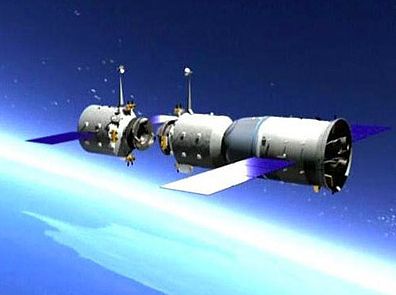
China’s 8½-ton space lab will soon crash to Earth. No one knows where it will hit.
by Mary Hui October 16, 2017 (washingtonpost.com)
• China’s prototype space station, launched in 2011, is out of control and will crash somewhere on the Earth before the end of the year.
• The space station measures 34 feet and weighs 8.5 tons.
• Chunks as large as 220 lbs may hit the Earth.
• Controlled spacecraft are typically guided to crash in a 2.5 mile-deep spot in the Pacific Ocean, 3000 miles east of New Zealand, known as the “spacecraft cemetery” where more than 263 derelict spacecraft have been dumped.
• China currently has a second space station in orbit and plans to have a permanent space station by 2020.
Sometime within the next few months, the heavens will come crashing down.
Tiangong 1, which translates to “Heavenly Palace,” is China’s first space laboratory, launched in September 2011, serving as a prototype for a permanent space station that it aims to eventually build and launch. But six years after it first went into orbit, the 8½-ton laboratory is soon expected to meet a fiery and uncontrolled end, hurtling down to Earth and crashing somewhere — anywhere — on the planet.
In September 2016, Chinese officials confirmed that they had lost control of the space lab and that it would crash into Earth sometime in the latter half of 2017. In May, China told the United Nations that the lab would reenter Earth between October and April 2018.
Much of the space lab, which measures 34 feet in length, is expected to burn up during its reentry. But Jonathan McDowell, an astrophysicist from Harvard University, told the Guardian that pieces weighing up to 220 pounds could make it to the Earth’s surface.
Where exactly the craft will fall is anyone’s guess. Even slight changes in atmospheric conditions can alter the landing site “from one continent to the next,” McDowell told the Guardian.
“You really can’t steer these things,” he said. “Even a couple of days before it reenters, we probably won’t know better than six or seven hours, plus or minus, when it’s going to come down. Not knowing when it’s going to come down translates as not knowing where it’s going to come down.”
Uncontrolled crashes of larger spacecraft, while rare, have happened before. The Soviet Salyut 7 space station crashed to Earth in 1991, while NASA’s Skylab space station fell over Western Australia in 1979.
China launched Tiangong 2, its second experimental station, in September 2016. China is aiming to have a permanently manned space station in orbit by 2020.
The 2011 launch of Tiangong 1 was seen by some as a “potent political symbol” that marked an important step forward in China’s expanding space program. It was regarded as a geopolitically significant event, part of China’s broader space program through which it wants to assert its emergence as a new superpower.
FAIR USE NOTICE: This page contains copyrighted material the use of which has not been specifically authorized by the copyright owner. ExoNews.org distributes this material for the purpose of news reporting, educational research, comment and criticism, constituting Fair Use under 17 U.S.C § 107. Please contact the Editor at ExoNews with any copyright issue.
China, Space Station, spacecraft cemetery